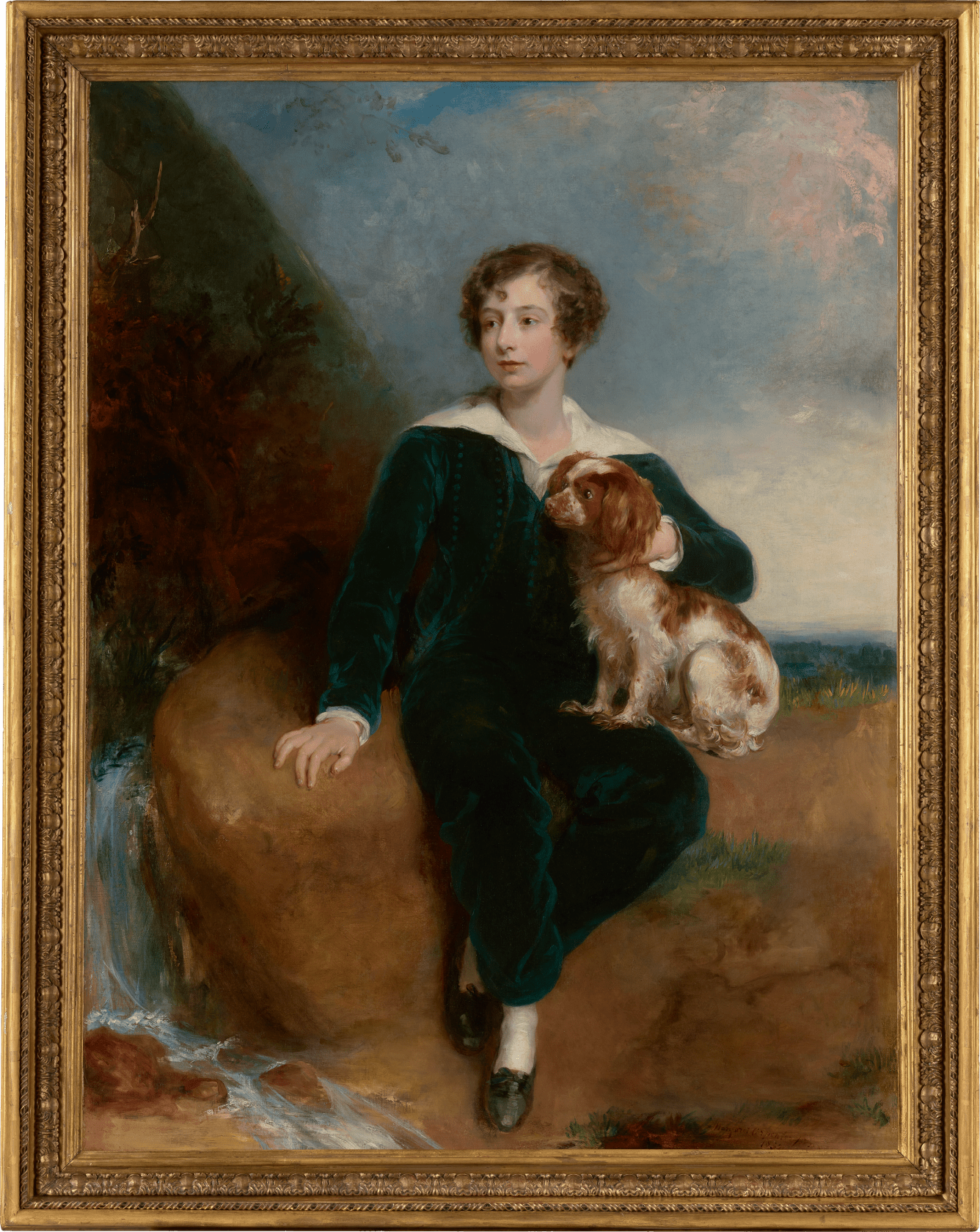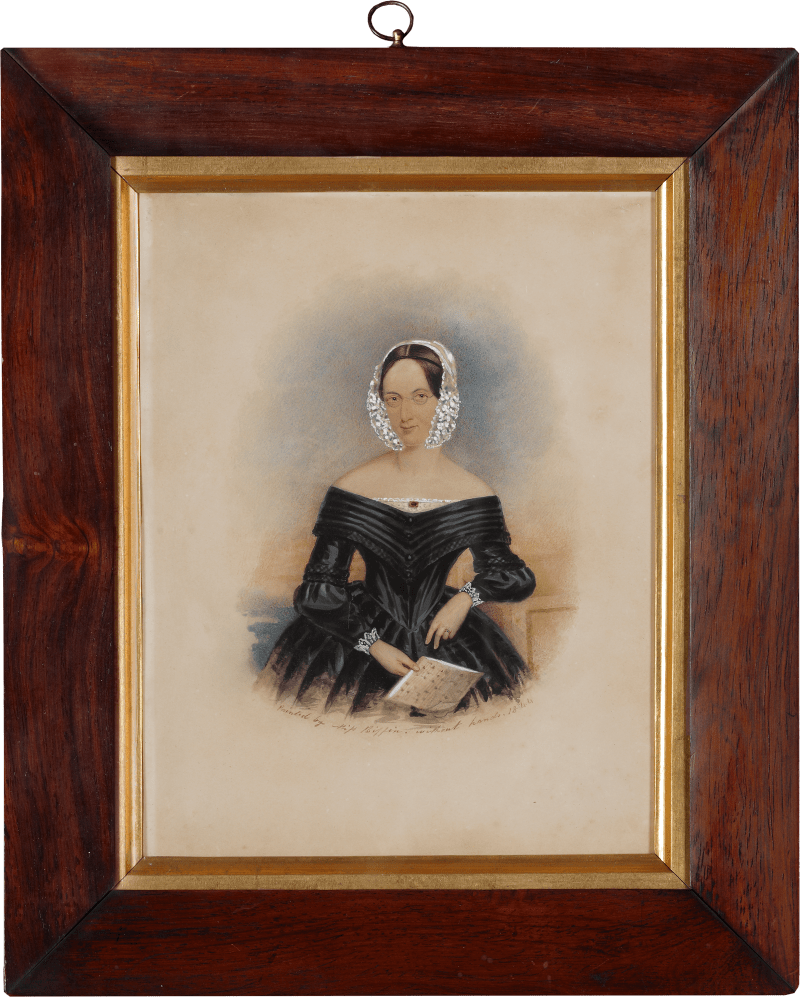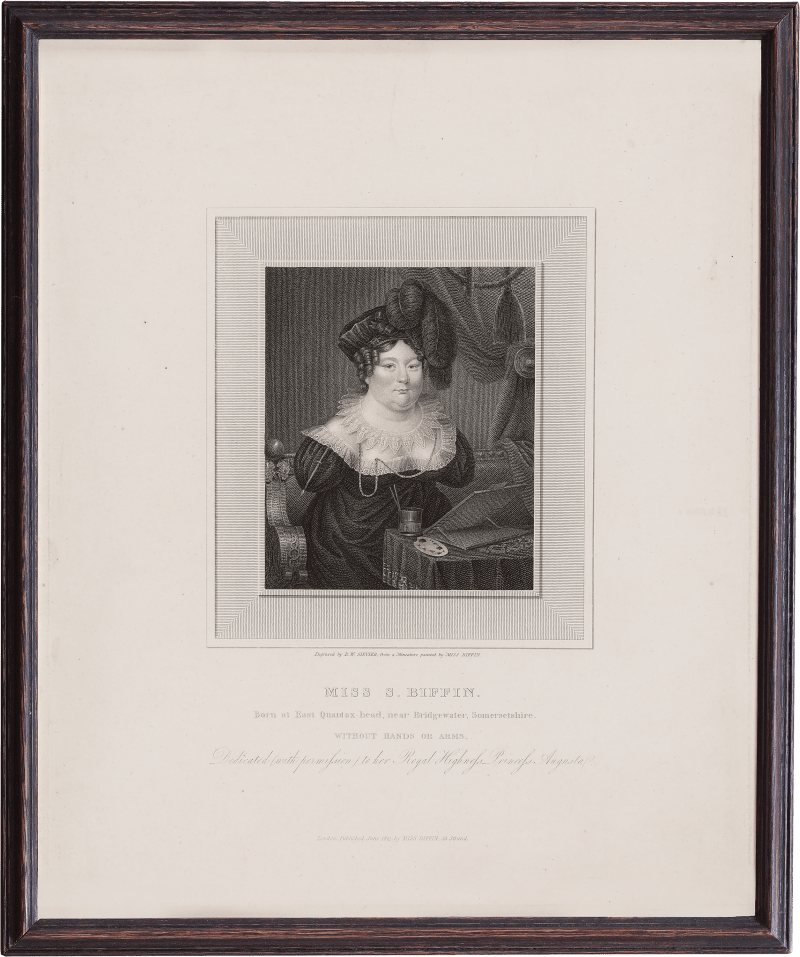Adorned in an emerald-green velvet suit, this endearing portrait of a young boy, Master Brownlow Bertie-Mathew (1820-1834), can be considered one of Margaret Sarah Carpenter’s most accomplished works. It was exhibited at the Royal Academy in 1832, at the height of her career, and is a bold reminder of her unrivalled status as the most celebrated British female portrait painter of the nineteenth century.[1]
Many artists of the 1830s sought to emulate the glistening elegance of Sir Thomas Lawrence’s society portraits, yet here Carpenter holds her own with a subtle, introspective interpretation. This portrait belongs to a pictorial tradition exemplified in Sir Thomas Lawrence’s Portrait of Charles William Lambton (known as ‘The Red Boy’) [fig. 1], in which elegance and romance are blended with sentiment and the fragility of youth.
Master Brownlow wears a rich velvet suit and is poised upon a grassy rock, contemplating nature and epitomising the poetic child wanderer. A mountain stream cascades at his...
Adorned in an emerald-green velvet suit, this endearing portrait of a young boy, Master Brownlow Bertie-Mathew (1820-1834), can be considered one of Margaret Sarah Carpenter’s most accomplished works. It was exhibited at the Royal Academy in 1832, at the height of her career, and is a bold reminder of her unrivalled status as the most celebrated British female portrait painter of the nineteenth century.[1]
Many artists of the 1830s sought to emulate the glistening elegance of Sir Thomas Lawrence’s society portraits, yet here Carpenter holds her own with a subtle, introspective interpretation. This portrait belongs to a pictorial tradition exemplified in Sir Thomas Lawrence’s Portrait of Charles William Lambton (known as ‘The Red Boy’) [fig. 1], in which elegance and romance are blended with sentiment and the fragility of youth.
Master Brownlow wears a rich velvet suit and is poised upon a grassy rock, contemplating nature and epitomising the poetic child wanderer. A mountain stream cascades at his side through movement rendered with liquid precision. Carpenter’s handling of paint, characterised by smooth transitions of tone and a refined modulation of light across skin, fabric, and fur, demonstrates her assimilation of Lawrence’s bravura with a degree of sensitivity to texture that evaded many of his less capable followers.
In both scale and ambition, the present work was likely always intended as an exhibition piece, and it was shown at the Royal Academy in 1832, where it received high praise: ‘Mrs. W. Carpenter, who seems determined to give us no opportunity of dispraising her, has again excelled herself. Her portrait of Master Brownlow Bertie Mathew (458) is an unrivalled effort, deserving of all commendation’.[2] Carpenter was deemed superior to many of her male peers and was often compared to Lawrence. One contemporary journalist pointedly asked: ‘How many of our male artists does Mrs. Carpenter put to the blush ever season?’.[3] Her success is evident in her remarkable output, having produced around a thousand works and exhibited over 240 of them during her lifetime.[4] Her sitters’ list, which is peppered with prestigious figures, logs more than six hundred names.[5] Carpenter’s portraits of children, whether painted on a bust-length or full-length scale, are painted with a distinct sensitivity.
Master Brownlow Bertie-Mathew was a grandson of General Edward Mathew (1728-1805), a British commander during the American War of Independence and, later, a governor in the West Indies. His wife Jane (née Bertie) (1720-1793) was a daughter of Peregrine Bertie, 2nd Duke of Ancaster and Kesteven (1686-1742). After General Mathew returned from the West Indies, the family resided in several properties in Hampshire, close to Jane Austen’s home. Master Brownlow, who was born in Jane Austen country, was named after his father, Brownlow Bertie-Mathew (1760-1826), and took the additional name of Bertie by royal licence in 1819. Here, Master Brownlow wears a fashionable velvet ‘skeleton suit’, consisting of a close-fitting jacket with an ornamental row of buttons and a matching pair of ankle-length pantaloons. This type of outfit was usually tailored for outdoor pursuits, as befits this setting. His hairstyle is typical of the early 1830s: natural, almost covering the ears, and parted on the side. Taken together with his wavy hair and forehead curls, the boy’s alabaster skin and white open collar are reminiscent of many portrayals of Lord Byron.[6] Intriguingly, Carpenter went on to be one of the very few artists to paint Byron’s only legitimate daughter, the mathematician Ada King (1815–1852), Countess of Lovelace [fig. 2].
Carpenter’s sitters’ book records three payments under the name Bertie-Mathew between 1824 and 1832.[7] The payment made in 1832 refers to our portrait.[8] This portrait was painted after Bertie was admitted to Eton College in 1826.[9] Carpenter was well-acquainted with the Reverend Edward Coleridge, Master at the College, and between 1824 and the mid-1840s, she painted around twenty-six official ‘leaving portraits’, often staying at Eton for long periods to work on her commissions.[10] Pupils’ parents may have also requested additional portraits from the artist, and it is possible that Portrait of Master Brownlow Bertie-Mathew was commissioned within this context. Unbeknownst to Carpenter, just like Lawrence’s Red Boy, her sitter would not reach adulthood. Master Brownlow died on 31st January 1834, aged only thirteen, and was buried on 8th February 1834 at St Marylebone Churchyard.[11] [12]
Carpenter was a self-taught child prodigy, and within her native Wiltshire, she became a local celebrity. Living near Longford Castle, she was invited by Jacob Pleydell-Bouverie (1750-1828), 2nd Earl of Radnor, to observe and copy works in his collection. She took tuition with local artist Thomas Guest (1754–1818), and, as Richard Smith has speculated, may also have studied briefly with Lawrence around 1812 during a formative year in London.[13] The Earl of Radnor strongly believed in her talents and supported her when she launched her career in 1813. He provided patronage and offered her his London home for a short time, where she started her professional practice.[14] In 1814, Carpenter won the Society of Arts’ Principal Gold Medal. Following this success, her paintings were publicly acclaimed, attracting a broad patronage base. She was actively immersed in the artistic circles of Hampstead, where she met painters John Constable (1776-1837) and her future brother-in-law William Collins (1788-1847). In 1817, she married William Hookham Carpenter (1792-1866), the son of a well-known bookseller and art dealer, who was later appointed Keeper of Prints and Drawings at the British Museum. Praised during her lifetime for her ‘simplicity and truth’, Carpenter continues to command admiration today as one of the most accomplished portraitists of her generation.[15]
[1] Richard J. Smith, (1993) “Margaret Carpenter (1793-1872): a Salisbury artist restored” in The Hatcher Review, vol. IV, n. 36, Autumn 1993, p. 5.
[2] Morning Post, 5 May 1832, p. 3.
[3] Naval & Military Gazette and Weekly Chronicle of the United Service, 25 February 1837, p. 11.
[4] Richard J. Smith, (1993) Margaret Carpenter (1793-1872): a 200th Anniversary Exhibition: 7 August to 30 October 1993. Salisbury: Salisbury & South Wiltshire Museum, p. 4.
[5] Paris A. Spies-Gans, (2022) A Revolution on Canvas: The Rise of Women Artists in London and Paris, 1760-1830. London: Paul Mellon Centre, p.165; “MSC – Margaret Sarah Carpenter, transcript of list of paintings 1812-1866” Heinz Archive, National Portrait Gallery, London.
[6] See the portraits of Byron by George Henry Harlow (1787-1819) and James Holmes (1777-1860).
[7] These were recorded as follows: in 1824, a payment of £31.10; in 1827, another payment of £31.10; and in 1832, a payment of £63. See NPG, Heinz Archives, List of Pictures and Drawings by Margaret Carpenter from the year 1812 to 1864 with the prices paid for them.
Usually, Carpenter charged £31.10 for a half-length portrait. It is therefore likely that £63 was paid for the full-length portrait of Master Brownlow. The List, or sitters’ book, was loosely copied from a document lent to the NPG by Edward Carpenter, the artist’s son, in 1899. According to Smith, the sitters’ book ‘in general indicates who paid rather than who sat’. See Richard J. Smith (1993) “Margaret Carpenter (1793-1872): a Salisbury artist restored” in The Hatcher Review, vol. IV, n. 36, Autumn 1993, p. 22.
[8] The payment made in 1824 could be related to a picture of Mr Brownlow Bertie-Mathew. The payment made in 1827 could refer to a portrait of Bertie Bertie-Mathew, Master Brownlow’s older brother, painted when he was admitted to Eton College in 1826.
[9] Eton School Lists 1791-1850 (available on Ancestry.co.uk).
[10] Richard J. Smith (1993), Margaret Carpenter (1793-1872): a 200th Anniversary Exhibition, p. 5.
[11] Morning Post, 3 February 1834, p. 4.
[12] London, England, Church of England Deaths and Burials, 1813-2003 (available on Ancestry.co.uk).
[13] Richard J. Smith, (1993) “Margaret Carpenter (1793-1872): a Salisbury artist restored,” pp. 13-14.
[14] The address was 52 Lower Grosvenor Street. See Richard J. Smith (1993) “Margaret Carpenter (1793-1872): a Salisbury artist restored”, p. 16.
[15] Morning Post, 13 April 1833, p. 3.











